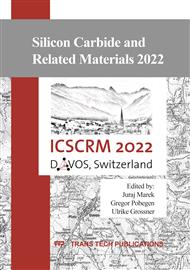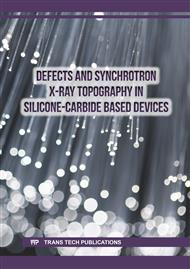[1]
H. Das, S. Sunkari, J. Justice, H. Pham, K.S. Park, Effect of defects in silicon carbide epitaxial layers on yield and reliability, Mater. Sci. Forum 963 (2019) 284-287.
DOI: 10.4028/www.scientific.net/msf.963.284
Google Scholar
[2]
T. Kimoto, A. Iijima, H. Tsuchida, T. Miyazawa, T. Tawara, A. Otsuki, T. Kato, Y. Yonezawa, Understanding and reduction of degradation phenomena in SiC power devices, 2017 IEEE International Reliability Physics Symposium (IRPS) (2017) 2A-1.1-2A-1.7.
DOI: 10.1109/irps.2017.7936253
Google Scholar
[3]
M. Dudley, F. Wu, H. Wang, S. Byrappa, B. Raghothamachar, G. Choi, S. Sun, E.K. Sanchez, D. Hansen, R. Drachev, S.G. Mueller, M.J. Loboda, Stacking faults created by the combined deflection of threading dislocations of Burgers vector c and c+a during the physical vapor transport growth of 4H–SiC, Appl. Phys. Lett. 98 (2011) 232110..
DOI: 10.1063/1.3597226
Google Scholar
[4]
F.Z. Wu, M. Dudley, H.H. Wang, S.Y. Byrappa, B. Raghothamachar, E. Sanchez, G.Y. Chung, D.M. Hansen, S.G. Mueller, M.J. Loboda, The Nucleation and Propagation of Threading Dislocations with C-Component of Burgers Vector in PVT-Grown 4H-SiC, Mater. Sci. Forum 740-742 (2013) 217-220.
DOI: 10.4028/www.scientific.net/msf.740-742.217
Google Scholar
[5]
M. Dudley, H.H. Wang, F.Z. Wu, S.Y. Byrappa, B. Raghothamachar, G. Choi, E. Sanchez, D.M. Hansen, R. Drachev, S.G. Mueller, M.J. Loboda, Formation Mechanism of Stacking Faults in PVT 4H-SiC Created by Deflection of Threading Dislocations with Burgers Vector c+a, Mater. Sci. Forum, 679-680 (2011) 269-272.
DOI: 10.4028/www.scientific.net/msf.679-680.269
Google Scholar
[6]
H. Tsuchida, M. Ito, I. Kamata, M. Nagano, Formation of extended defects in 4H-SiC epitaxial growth and development of a fast growth technique, Phys. Status Solidi B 246 (2009) 1553-1568.
DOI: 10.1002/pssb.200945056
Google Scholar
[7]
Q.Y. Cheng, H.Y. Peng, S.S. Hu, Z.Y. Chen, Y.F. Liu, Ray-Tracing Simulation Analysis of Effective Penetration Depths on Grazing Incidence Synchrotron X-Ray Topographic Images of Basal Plane Dislocations in 4H-SiC Wafers, Mater. Sci. Forum 1062 (2022) 366-370.
DOI: 10.4028/p-2kzz01
Google Scholar
[8]
X.R. Huang, M. Dudley, W.M. Vetter, W. Huang, W. Si, C.H. Carter Jr, Superscrew dislocation contrast on synchrotron white-beam topographs: an accurate description of the direct dislocation image, J. Appl. Cryst. 32 (1999) 516-524.
DOI: 10.1107/s0021889899002939
Google Scholar
[9]
H. Peng, T. Ailihumaer, F. Fujie, Z. Chen, B. Raghothamachar, and M. Dudley, Influence of surface relaxation on the contrast of threading edge dislocations in synchrotron X-ray topographs under the condition of g . b = 0 and g . b x l = 0, J. Appl. Cryst. 54 (2021) 439-443.
DOI: 10.1107/s160057672100025x
Google Scholar
[10]
F. Fujie, H. Peng, T. Ailihumaer, B. Raghothamachar, M. Dudley, S. Harada, M. Tagawa, and T. Ujihara, Synchrotron X-ray topographic image contrast variation of screw-type basal plane dislocations located at different depths below the crystal surface in 4H-SiC, Acta Mater. 208 (2021) 116746.
DOI: 10.1016/j.actamat.2021.116746
Google Scholar
[11]
T. Ailihumaer, H. Peng, F. Fujie, B. Raghothamachar, M. Dudley, S. Harada, and T. Ujihara, Surface relaxation and photoelectric absorption effects on synchrotron X-ray topographic images of dislocations lying on the basal plane in off-axis 4H-SiC crystals, Mater. Sci. Eng.: B 271 (2021) 115281.
DOI: 10.1016/j.mseb.2021.115281
Google Scholar
[12]
J. Guo, Y. Yang, F. Wu, J. Sumakeris, R. Leonard, O. Goue, B. Raghothamachar, M. Dudley, Direct Determination of Burgers Vectors of Threading Mixed Dislocations in 4H-SiC Grown by PVT Method, J. Electron. Mater. 45 (2016) 2045-2050.
DOI: 10.1007/s11664-015-4317-0
Google Scholar
[13]
Q. Cheng, T. Ailihumaer, Y. Liu, H. Peng, Z. Chen, B. Raghothamachar, M. Dudley, Characterization of Dislocations in 6H-SiC Wafer Through X-Ray Topography and Ray-Tracing Simulations, J. Electron. Mater. 50 (2021) 4104-4117.
DOI: 10.1007/s11664-021-08888-7
Google Scholar
[14]
T. Ailihumaer, H. Peng, Y. Liu, Q. Cheng, Z. Chen, S. Hu, B. Raghothamachar, M. Dudley, Analysis of Dislocation Contrast in Synchrotron Grazing-incidence X-ray Topographs and Ray-tracing Simulation in Off-axis 4H-SiC Crystals, ECS Trans. 104 (2021) 157-169.
DOI: 10.1149/10407.0157ecst
Google Scholar
[15]
B. Raghothamachar, Y. Liu, H. Peng, T. Ailihumaer, M. Dudley, F.S. Shahedipour-Sandvik, K.A. Jones, A. Armstrong, A.A. Allerman, J. Han, H. Fu, K. Fu, Y. Zhao, X-ray topography characterization of gallium nitride substrates for power device development, J. Cryst. Growth, 544 (2020) 125709.
DOI: 10.1016/j.jcrysgro.2020.125709
Google Scholar
[16]
T. Zhou, B. Raghothamachar, F. Wu, M. Dudley, Grazing Incidence X-ray Topographic Studies of Threading Dislocations in Hydrothermal Grown ZnO Single Crystal Substrates, MRS Online Proc. Libr. 1494 (2012) 121-126.
DOI: 10.1557/opl.2013.261
Google Scholar
[17]
M. Dudley, X.R. Huang, W. Huang, Assessment of orientation and extinction contrast contributions to the direct dislocation image, J. Phys. D: Appl. Phys. 32 (1999) A139-A144.
DOI: 10.1088/0022-3727/32/10a/329
Google Scholar
[18]
C. Schneider, W. Rasband, K. Eliceiri, NIH Image to ImageJ: 25 years of image analysis, Nat. Methods 9 (2012) 671-675.
DOI: 10.1038/nmeth.2089
Google Scholar
[19]
A. Authier, Contrast of Dislocation Images in X-Ray Transmission Topography, Adv. X-Ray Anal. 10 (1966) 9-31.
DOI: 10.1154/s0376030800004250
Google Scholar
[20]
M. Dudley, J. Wu, and G.-D. Yao, Determination of penetration depths and analysis of strains in single crystals by white beam synchrotron X-ray topography in grazing Bragg-Laue geometries, Nucl. Inst. & Meth. B40/41 (1989) 388-392.
DOI: 10.1016/0168-583x(89)91005-7
Google Scholar
[21]
H. Peng, T. Ailihumaer, Y. Liu, B. Raghothamachar, X. Huang, L. Assoufid, and M. Dudley, Dislocation contrast on X-ray topographs under weak diffraction conditions, J. Appl. Crystallogr. 54 (2021) 1225-1233.
DOI: 10.1107/s1600576721006592
Google Scholar



